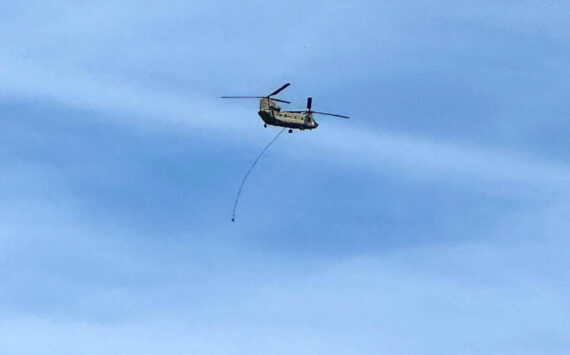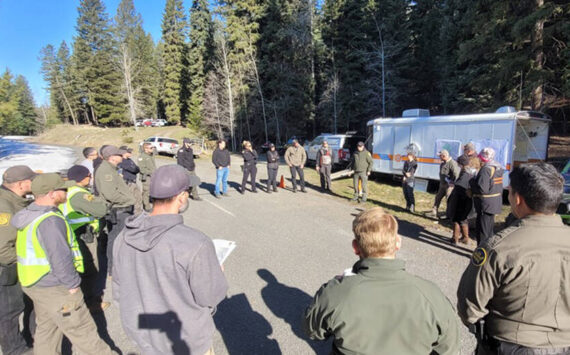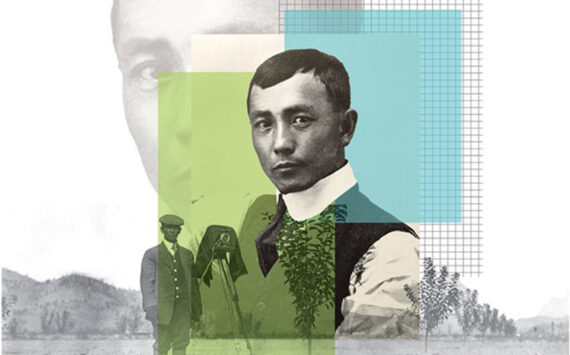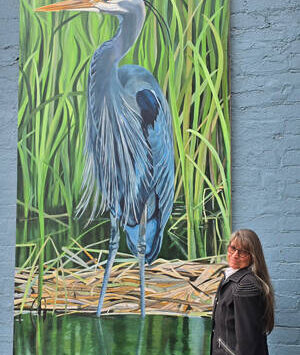
Cloyd Artman piloting a glider from an April 1935 photo from an article in the Spokesman Review. Spokesman Review photo
OROVILLE – Cloyd Artman, who grew up in Oroville, was among the pioneers of glider construction and flight in the United States in the 1930s, according to Linda Chisom, who has been tracing the pilot’s history, going back to his first home-built glider when Artman was 15-years-old.
Chisom, herself a small plane and sailplane pilot, was the guest of the Okanogan Borderlands Historical Society and was asked to speak on Artman and his sister Audrey, who also learned to pilot gliders in the hills surrounding Oroville.
“It’s a wonderful history for us. I am a pilot of small airplanes and have flown sailplanes for a number of years out of Ephrata,” said Chisom, an attorney who lives in Seattle.
Chisom said she heard the name Cloyd Artman in regards to gliders and became curious. That’s what started her research and led her to Oroville and later to Grand Coulee Dam, Wenatchee, Pullman and the Snake River Gorge.
“This story started in 1929 Oroville in Cloyd and Audrey’s hometown. When Cloyd was 15 he saw a National Geographic article about a German glider club where they were learning to fly for free. The gliders were launched from hills after being pulled up by oxen,” Chisom said. “Building and flying gliders was a popular pastime in Germany between the wars.”
She said the young high school student then read a six-part series of articles in Popular Aviation on how to build a glider. The article was in German and had been translated into English. Artman decided to try his hand at building his own glider.
“His first glider, The Golden Dawn, was built when he was a senior in high school in 1932. It had a 30-foot wingspan and the wings were covered with muslin from the dry goods store. It had butcher paper covering the tail. He rigged up a pick handle for rudder control and had a surveyor’s altimeter. He got support in building the project from his Manual Arts teacher Mr. Nelson,” she said.
Artman, who was self-taught, first launched The Golden Dawn from what was then a baseball field by where Immaculate Conception Catholic Church is now located. His first three flights he got up to about 300 feet, according to Chisom.
“Mr. Nelson and his wife pulled the glider with their car,” she said. “Later Cloyd flew from the site of Oroville’s first airport, located where the Desert Breeze condominiums are being developed between Main Street and the river. He did many of his early flights by “autotow” being pulled like a kite behind a car until and then unhooking.
“Ellemeham Mountain was Cloyd’s first mountain soaring site and east to Mt. Hull was where he launched his biggest flights,” said Chisom. “In his first soaring flight he flew for two hours and landed at the ballpark at the north end of town. He took a picture of Oroville at 3000 feet.”
In addition to the altimeter and camera, Artman was also fond of taking his lunch or snacks, as well as his harmonica and even a coronet, according to Chisom.
To launch the 175-pound craft Artman would use automobiles and other means. He once used a horse to pull a thin wire to get him airbourne.
“They often did bungy launches, using old inner tubes knotted together to slingshot the glider. His volunteer ground crew of local boys was usually at hand to help him with the launches or to pull the glider back up hill.
“It required a lot of hands and the young boys of Oroville, some still around today, were his helpers,” said Chisom.
During those early days Artman was pretty much one of the few glider pilots in the American West, with most of the activity in the Eastern United States, according to Chisom, who added that it was a rich man’s sport with pilots with names like Dupont.
Artman had flights of up to eight hours, which would have placed him in the record books. His sister Audrey also learned to fly and was Washington State’s first female glider pilot. Her first flight was in October of 1932 when she was a junior at Oroville High School.
“She flew for three hours which was an unofficial word record for women. She was one of five known women to be a glider pilot in the United States… one was Mrs. Dupont, one was Anne Lindburg and one was Amelia Earhart.
Cloyd Artman was very active in flying his glider in 1932 and 1933 after he graduated from Oroville High School. He went to work for two years making boxes at Zosel’s Lumber in order to earn money to go to Washington State College in Pullman.
“He did night flights where cars were lined up with their headlights shining for landings. He had several small mishaps and went through four sets of wings. He flew to Nighthawk and back, which is believed to be an unofficial training glider record.
After saving up his money in the fall of 1934 Artman went to WSC, now Washington State University, where he studied Mechanical Engineering. He founded the WSC Aero Club in the fall of 1935 and the club bought and built a Mead kit glider. Autotow and wire tow demonstrations were given on various college athletic fields, according to Chisom. The club launched from the current site of Steptoe Butte Park near Colfax, which was under private ownership at the time.
“The site was a favorite training area because there was wind from almost any point of the compass,” Chisom said. “It was a perfect place to learn gliding.”
Later when the farmer would no longer let them launch there, the club moved south of Pullman to the Snake River Gorge. Just downstream of Wawawai County Park, on the banks of the Snake River is where the Inland Grain Tram line ran to railroad tracks by the river. The group used the cables of the tram to launch their craft.
Artman also flew his glider in the hills around Grand Coulee, giving demonstrations while the Grand Coulee Dam was still under construction in the mid-1930s. The event was covered by the Pathay Newsreel cameras of the day. In addition, he and the Aero Club arranged the state’s first souring meet at Wenatchee. Artman won the competition for longest time in the air and distance. He was the first person to ever soar in the area, having tested the area out earlier with launches off Badger Mountain.
He was launched by elastic bands, and the glider was even launched from atop a greased board tilted off the back of a Model A Ford, according to Chisom.
He was also invited to fly demonstrations at Boeing Field at Duwamish Industrial Club Aviation Exhibition. By this time he had built and was flying the Lone Eagle, a glider he designed himself. In 1935 the Lone Eagle was destroyed in a car accident while being pulled down the road on a trailer. Artman returned home to Oroville to build another glider and the business people in town loaned him the funds to build the Lone Eagle II.
He used the new glider to do exhibitions to raise money to repay the loan and for college.
“He also wanted to get Washington State on the radar for gliding and pledged to find the best spot for gliding in the state,” Chisom said. ‘In mid-July of 1935 he flew at a record 5700 feet after launching from Mt. Hull. He is reported to have done some loops over town,” Chisom said.
Artman corresponded with several other glider pilots, including one named Vulner from the west side of the state. He owned an enclosed VJA glider. He had the glider shipped to Oroville where the two flew together for more than 3 hours. Vulner stored his glider in Oroville and returned that April to fly with Artman again.
“Cloyd bombed Vulmer with apple cores and played charge on the
bugle until Vulmer could take off and join him in the air,” said Chisom.
Several newspapers throughout the state followed Artman and his sister’s exploits, describing Audrey as “the pretty blond pilot,” according to Chisom. In September 1935 Popular Mechanics had an illustration of Artman and his glider on the greased board being launched from the top of the Model A. Several articles on Artman can also be found in the archives of WSU.
Club members and his Mechanical Engineering professor built an enclosed, two person high- performance glider and named it The Comet. Artman insisted on taking the glider up on its maiden flight by himself and flew it solo for three days at Steptoe Butte, the longest flight being three hours. On Sunday, April 11, 1937 tragedy struck. He and fellow club member Frank See, Audrey’s fiancé took the craft up on its first two-man flight. According to newspaper reports of the time the glider “plummeted more than 400 feet into the rocks along the Snake River.”
“The wings folded up and they died instantly in the crash. The club members later met and burned the remains of the glider where it crashed,” said Chisom.
His obituary appeared in the May 1937 issue of Soaring magazine where they said they were shocked to learn of the death of “one of our most courageous and prominent members.”
Cloyd Artman is buried at Oroville’s Riverview Cemetery in Oroville. His funeral was attended by several of his fellow club members.
His sister Audrey, a pioneer glider pilot in her own right, was enrolled at WSC at the time herself. She witnessed the accident and never flew a glider again. She later married a Canadian miner from Osoyoos. There sister, Peggy Northcott, still lives near Oroville at Chesaw.
Chisom is developing a package on the Artmans to be displayed at museums and hopes to make it available to the Museum of Flight in Seattle, the Smithsonian and the National Soaring Museum in New York. Chisom also plans to be in attendance at Dorothy Scott Airport Day next summer.








Comments are closed.